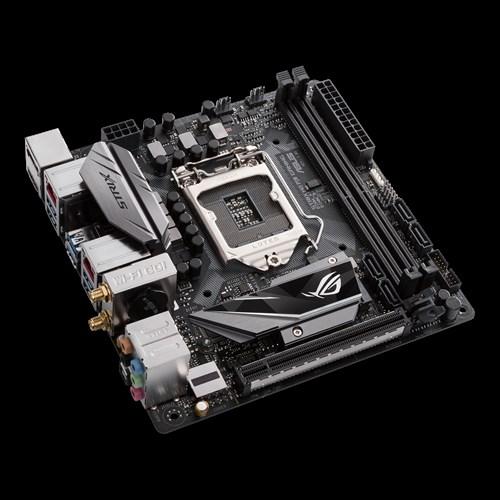Asus ROG Rolls Out Two Mini-ITX Strix Motherboards




Asus announced the immediate availability of the ROG Strix H270I Gaming and ROG Strix B250I Gaming motherboards. The latest editions to the ROG Strix line of motherboards are both mini-ITX, based on Intel's H270 and B250 chipset respectively. These two models are almost identical, physically speaking, differing only in a few minor components and chipset features.
Both models possess many features you'd expect from full-sized Intel-based Strix motherboards such as support for 6th (Skylake) and 7th (Kaby Lake) generation Intel Core desktop processors, DDR4 support, PCIe 3.0 x16 slot, dual gigabit LAN, USB 3.1 Type-A/C, Bluetooth 4.1, dual Intel Optane-ready M.2 sockets, and 8-channel HD audio, all bundled into a tiny 6.7 x 6.7" package.
The Strix H270I Gaming has two gigabit LAN ports whereas the Strix B250I Gaming has a single gigabit LAN port. Both motherboards employ Asus' LANGuard surge protection and can be managed using the GameFirst IV traffic management software. Due to the mini-ITX form factor, these motherboards have two memory slots that therefore limit system memory to 32GB. Integrated graphics output is handled via DisplayPort 1.2 or HDMI 1.4 ports on the rear I/O panel.
The company also included features found on its higher-end motherboards, such as AURA Sync RGB lighting, a 4-pin RGB lighting header, 802.11ac dual-band Wi-Fi, SafeSlot reinforced PCI-E slot, Q-LEDs, Digi+ VRMs, DRAM Overcurrent Protection, and its unique thermally isolated "double-decker" PCH chipset / M.2 drive heatsink. There are a total of three 4-pin fan headers on each motherboard. Even though all three fan headers can be used for PWM fans, one header is specifically designed to accommodate a high amp fan or water pump. All fan headers can be managed through Fan Xpert 4 Core.
The ROG Strix H270I Gaming and ROG Strix B250I Gaming motherboards are available now for $120 and $110, respectively.




| Header Cell - Column 0 | Asus ROG Strix H270I Gaming | Asus ROG Strix B250I |
|---|---|---|
| Socket | 1151 | 1151 |
| Chipset | Intel H270 Chipset | Intel B250 Chipset |
| DDR4 Memory | 3800(OC) / 3600(OC) / 3200(OC) / 3000(OC) / 2800(OC) / 2600(OC) / 2400 / 2133 MHz | 2400 / 2133 MHz |
| Memory Channel | Dual | Dual |
| DIMM Slots | 2 | 2 |
| Max Memory | 32GB | 32GB |
| PCI-E x16 | 1 | 1 |
| SATA III | 4 | 4 |
| M.2 Slot | 2 | 2 |
| TPM Header | 1 | 1 |
| LAN | 10/100/1000 | 10/100/1000 |
| Rear I/O | 1 x DisplayPort1 x HDMI2 x LAN (RJ45) ports6 x USB 3.1 Gen 1 (blue)1 x Optical S/PDIF out5 x audio jacks1 x Wi-Fi antenna port | 1 x DisplayPort1 x HDMI1 x LAN (RJ45) port4 x USB 3.1 Gen 12 x USB 2.05 x audio jacks1 x Wi-Fi antenna port |
| Form Factor | mini-ITX | mini-ITX |
| Price | $120 | $110 |
Get Tom's Hardware's best news and in-depth reviews, straight to your inbox.
Steven Lynch is a contributor for Tom’s Hardware, primarily covering case reviews and news.
-
DerekA_C starting to wonder if Intel is playing a role in this at this point, just going by their history when it comes to AMD.Reply -
John Heller Great looking boards, now how about a B350 version so we can make some crazy good Ryzen ITX systemsReply -
TheFuzzz included nothing but Asus in my systems in the past years. will consider changing to whoever rolls out a ryzen itx board that is worthy.Reply -
kinney It's not that anyone is an AMD fan, it's just where the action is at right now. I built myself a Biostar X370GTN / R7 1700 in a Node202 and it's an amazing setup. Would love to have an Asus to use for the same.Reply